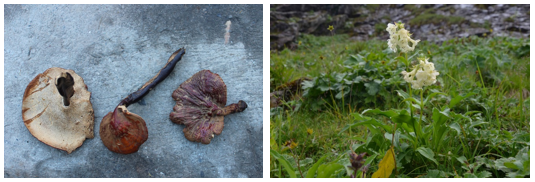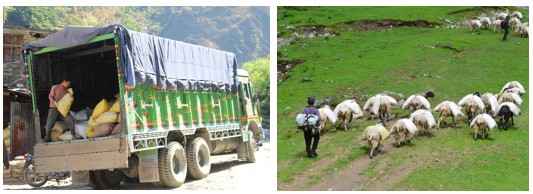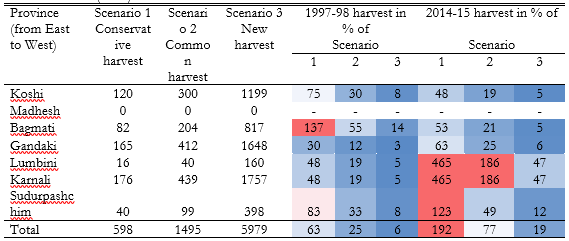The Sustainability of the Environmental Product Trade: Joining Ecology and Economics in the Nepali Himalayas
Professor Carsten Smith-Hall is global leader in environmental products and livelihoods research and teaching, with a strong track record of developing, funding, and managing international and interdisciplinary research and teaching projects, raising more than €32 million in external funding (99+ per cent as PI). He publishes in both natural and social science journals. His research is focused on environment-people relationships, including the role of forests in preventing and reducing poverty; commercial utilisation of biodiversity, with emphasis on trade and conservation; and the bioeconomy and climate change.
By Carsten Smith-Hall
Thoughts about the sustainable use of nature have a long history in relation to both practical interventions and the human condition, touching on both ecological and economic aspects. For instance, Harrison’s (1993) book on the role of forests in Western thought argues that radical ecological change in the form of deforestation is linked to an increasing sense of contemporary uncertainty about what it means to be human. Another example is the 2500-year-old proverb, “Give a man a fish, and you feed him for a day. Teach him how to fish, and you feed him for a lifetime”, attributed to the Chinese philosopher Laozi. However, thinking that explicitly joins ecological and economic sustainability dimensions is rare.
This post focuses on presenting a pragmatic and operational approach to sustainability, covering both ecology and economics, when considering environmental product trade: how can we measure sustainable biodiversity and livelihood outcomes? And how can this inform interventions to enhance species conservation and improve people’s lives? While environmental products are “tangible biotic and abiotic goods gathered from any biome or created through synthetic production” (Smith-Hall and Chamberlain, 2023: 494), the emphasis here is on wild-harvested renewable products collected for commercial purposes. Next, I present a brief overview of the concept of sustainability, then argue the need for an explicit definition and a general model that can be applied across cases. To illustrate the use of this approach, I apply it to the case of commercial medicinal plants harvested and traded from the Nepalese Himalaya and draw out general lessons learned.

Fig. 1 Thousands of plant and fungus species are commercially wild-harvested worldwide. Here from Nepal: (left) dried Ganoderma sp. mushrooms in Darchula District and (right) flowering Nardostachys jatamansi in Humla District. Photos by Carsten Smith-Hall and Dipesh Pyakurel.
What is sustainability?
There is a huge body of research on sustainability, with an example being the 1296 review papers specifically focused on sustainability within forestry alone (WoS, 2024). Sustainability is a versatile term used in many different ways. The Convention on Biological Diversity defines sustainable use as “the use of components of biological diversity in a way and at a rate that does not lead to the long-term decline of biological diversity, thereby maintaining its potential to meet the needs and aspirations of present and future generations” (CBD, 1992: 4). Although this definition implies achieving both ecological and economic sustainability simultaneously, specific definitions for each are lacking, though such examples are found in the environmental product literature. For instance, Coad et al. (2019) delineated ecological sustainability concerning bushmeat as maintaining harvested levels below those causing continuous prey population decline to zero, without significant ecological system repercussions, while economic sustainability involves sustaining a certain level of economic production and social well-being. However, commonly accepted definitions are lacking as are standardised methods for estimating ecological and economic sustainability.
Moreover, while there is considerable discussion on the necessity of sustainable environmental product harvesting, empirical studies are scarce. Meilby et al. (2014) identified three primary limiting factors: the expense, complexity of design, and difficulty of implementation of such studies. Challenges include the vast number and spatial distribution of products, short harvesting seasons, interdisciplinary collaboration requirements, and establishing and maintaining long-term monitoring plots. Acquiring data on harvested quantities, values, and species-level growth is not straightforward. Nonetheless, such data are imperative for advancing beyond reliance on proxies like harvester perceptions, which should be used cautiously. For example, Timmermann and Smith-Hall (2019) found that harvester perceptions of declining commercial medicinal plant availability in western Nepal reflected increased competition among collectors rather than decreased supply: individual harvests were lower, but community-level harvests remained constant.
Thus, despite global trade in thousands of wild-harvested plant species, standardised and valid data on harvested amounts and plant population statuses are lacking, hindering ecological and economic sustainability assessments. Here, we consider ecological sustainability a biological issue and economic sustainability an economic issue. Our point of departure is that (i) ecological sustainability is achieved at the species level when, in the long term, the annual harvest does not exceed the annual increment, and (ii) economic sustainability is achieved for an actor when, in the long term, a certain environmental income level can be maintained. Actors can be a household, community, processing company, industry, or nation. The two types of sustainability may or may not be achieved simultaneously, e.g. it is possible to achieve household-level economic sustainability if a commercially harvested species disappears as long as the associated environmental income can be derived from other species.

How can sustainability be measured?
Recognising the many factors influencing sustainability assessments, including site characteristics and taxonomic groups (Leão et al., 2017), integration and upscaling using multiple data sources show promise. Figure 3 presents a data-driven three-step parsimonious approach to assess the sustainability of commercial wild-harvested plant species (Smith-Hall et al., 2023). The first two steps involve data collection, and the third involves data analysis. Ecological data includes: (i) information to model the distribution area of a species in a specified geographical region such as a country; (ii) the quantity and weight of harvestable products per unit area and site type, ascertained through inventories; and (iii) the annual production of harvestable products per unit area and site type, established through yield or growth studies. Trade data includes: (iv) characteristics of the production network (value chain), including location, function, and types of actors, to facilitate the design of data collection on (v) volume (in kilograms) and (vi) value (USD per kilogram at specific network points). Data analysis involves the integration of ecological and trade data to assess sustainability—both ecological and economic—at relevant spatial (geographical or administrative) and temporal levels.

Fig. 3 The data-driven three-step analytical framework for assessing the sustainability of wild-harvested commercial plant species. Steps 1 and 2 are input variables, and Step 3 specifies output dimensions. Based on Smith-Hall et al. (2023).
While the model is straightforward, the primary challenge lies in acquiring the necessary data, given the limited information available on wild-harvested plants. For example, population ecology studies cover only 1% (Smith-Hall et al., 2020) of the 300 medicinal plant, fungus, and lichen species traded in Nepal (Pyakurel et al., 2019).
What comes out of using this approach to assessing sustainability? An example from Nepal
We applied this approach to the commercially wild-harvested perennial herb Nardostachys jatamansi in Nepal (Smith-Hall et al., 2023). This species is of particular interest as it is in a monotypic genus, subject to high and rising prices, with 82% of the annual global production from Nepal, and economically important to rural households (Olsen, 2005; Pyakurel et al., 2019). The results are presented in Table 1. Note the use of three sustainability scenarios reflecting increased sustainable harvests (e.g. scenario 1 assumes that plant populations are mainly found in habitats where the species is most susceptible to harvesting) and two case years (1997-98 and 2014-15).

Table 1. Estimates of sustainable harvest levels of air-dry N. jatamansi rhizomes (t) and shares (%) of the estimated 1997-98 and 2014-15 harvests in Nepal across three sustainability scenarios. From Smith-Hall et al. (2023).
Notes: Colours illustrate the degree of sustainability: red is unsustainable (>100% of the scenario harvest level), pink is moving close to unsustainable (>80%), and blue is sustainable (≤80%).
There are some clear patterns in the results. First, total harvest has increased substantially between the two observation periods, with the national harvest in 2014-15 exceeding the sustainable limit in the conservative harvest scenario 1. Second, harvesting has shifted to western Nepal, where harvesting in two provinces exceeds the sustainable limit of the common harvest scenario 2. Third, nowhere does the harvest exceed the limits in the new harvest scenario 3, indicating the scope to increase the annually harvested amount if the harvesting method is changed to regenerative harvesting (as shown by Larsen (2005), replanting of upper plant parts and 2 cm of the rhizome provides the fastest regeneration and rhizome biomass growth). Combining ecological and economic data improves our understanding of the sustainability of commercial harvests.
Concluding remarks
While there has been much talk about the sustainability of commercial medicinal plant trade in Nepal for decades, going back to the first scientific writings on these products (e.g. Dobremez, 1976), there has been almost no species-level hard data to support or refute claims of (un)sustainability, making it hard to disentangle imaginings and facts. This has led to the widespread circulation of unsubstantiated unsustainability claims in Nepal and elsewhere in Asia (Larsen and Olsen, 2007; Dejouhanet and Sreelakshmy, 2022), hindering the identification of appropriate interventions. The presented approach, emphasising integration of ecological and economic data at the species level, shows that we can do much better with what we have, providing an explicit way forward to establish more accurate assessments of the sustainability of trade in wild-harvested environmental products, applicable across species and geographical locations, and allowing analysis at different spatial and temporal scales. Considering the increasing importance of sustainability of industrial raw material supplies in Nepal (Blaikie and Craig, 2022; Caporale et al., 2020) and elsewhere (Kloos and Blaikie, 2022), such data-driven estimates can contribute to simultaneously promoting species conservation, increased rural household incomes in low-income production sites, the industry-related development of new jobs and skills, and increasing provincial and national incomes from environmental products.
However, given the cost of species-level data generation and the high number of species in trade, the presented approach should be focused on the key species in trade, measured in either conservation concern or economic importance to collectors. For the large majority of species of less concern, we need to work out simple management guidelines, such as the amount (e.g. 25% of the stock) that can be gathered in a specific area at specified intervals (e.g. every five years). This approach, besides being cheap and simple to communicate and implement, would also serve to guard local collection against being hijacked by apparent scientific demands to management masking an agenda to control resource flows and extract rents. This has recently been documented as a feature of decentralised forest management in Nepal (Baral et al., 2018; Basnyat et al., 2020, 2023) and needs to be avoided when developing the commercial medicinal plant industry.
Reference list
Baral, S., Meilby, H., Chettri, B.B.K., Basnyat, B., Rayamajhi, S. and Awale, S. 2018. Politics of getting the numbers right: Community forest inventory of Nepal. Forest Policy and Economics 91: 19-26.
Basnyat, B., Treue, T., Pokharel, R.K., Baral, S. and Rumba, Y.B. 2020. Re-centralisation through fake Scientificness: The case of community forestry in Nepal. Forest Policy and Economics 115: 102147.
Basnyat, B., Treue, T., Pokharel, R.K., Kayastha, P.K. and Shrestha, G.K. 2023. Conservation by corruption: the hidden yet regulated economy in Nepal’s community forest timber sector. Forest Policy and Economics 149: 102917.
Blaikie, C. and Craig, S.R. 2022. Making Tibetan medicine in Nepal. In Kloos, S. and Blaike, C. (Eds) Asian medical industries. New York: Routledge, pp. 253-279.
Caporale, F., Mateo-Martín, J., Usman, F. and Smith-Hall, C. 2020. Plant-based sustainable development – the expansion and anatomy of the medicinal plant secondary processing sector in Nepal. Sustainability 12(14): 5575.
CBD. 1992. Convention on Biological Diversity. United Nations, 28pp.
Coad, L., Fa, J.E., Abernethy, K., van Vliet, N., Santamaria, C., Wilkie, D., El Bizri, H.R., Ingram, D.J., Cawthorn, D.M. and Nasi, R. 2019. Towards a sustainable, participatory and inclusive wild meat sector. Bogor: Center for International Forestry Research, 199pp.
Dejounhanet, L. and Sreelakshmy, M. 2022. Untangling the web of raw material supply for Ayurvedic industry. In Kloos, S. and Blaike, C. (Eds) Asian medical industries. New York: Routledge, pp. 194-224.
Dobremez, J.F. 1976. Exploitation and prospects of medicinal plants in Eastern Nepal. In (no editor) Mountain Environment and Development, Kathmandu, Sahayogi Press, pp. 97-107.
Harrison, R.P. 1993. Forests – the shadow of civilisation. Chicago: The University of Chicago Press, 288pp.
Kloos, S. and Blaikie, C. (Eds) 2022. Asian medical industries. New York: Routledge, 352pp.
Larsen, H.O. 2005. Impact of replanting on regeneration of the medicinal plant Nardostachys grandiflora DC. (Valerianaceae). Economic Botany 59(3): 213–220.
Larsen, H.O. and Olsen, C.S. 2007. Unsustainable collection and unfair trade? Uncovering and assessing assumptions regarding central Himalayan medicinal plant conservation. Biodiversity and Conservation 16: 1679-1697.
Leão, T.C.C., Lobo, D. and Scotson, L. 2017. Economic and biological conditions influence the sustainability of harvest of wild animals and plants in developing countries. Ecological Economics 140: 14-21.
Meilby, H., Smith-Hall, C., Byg, A., Larsen, H.O., Nielsen, Ø.J., Puri, L. and Rayamajhi, S. 2014. Are forest incomes sustainable? Firewood and timber extraction and forest productivity in community managed forests in Nepal. World Development 64: S113-S124.
Olsen, C.S. 2005. Trade and conservation of Himalayan medicinal plants: Nardostachys grandiflora DC and Neopicrorhiza scrophulariiflora (Pennell) Hong. Biological Conservation 125:505–514.
Pyakurel, D., Smith-Hall, C., Bhattarai-Sharma, I. and Ghimire, S.K. 2019. Trade and conservation of Nepalese medicinal plants, fungi, and lichens. Economic Botany 73(4): 505-521.
Smith-Hall, C. and Chamberlain, C. 2023. Environmental products: a definition, a typology, and a goodbye to non-timber forest products. International Forestry Review 25(4): 491-502.
Smith-Hall, C., Chapagain, A., Das, A.K., Ghimire, S.K., Pyakurel, D., Treue, T. and Pouliot, M. 2020. Trade and conservation of medicinal and aromatic plants – an annotated bibliography for Nepal. Sopan Press, Central Department of Botany, Tribhuvan University, Kathmandu, 320pp.
Smith-Hall, C., Pyakurel, D., Meilby, H., Pouliot, M., Ghimire, P., Ghimire, S., Madsen, S.T., Paneru, Y.R., Subedi, B., Timoshyna, A. and Treue, T. 2023. The sustainability of trade in wild plants – a data-integration approach tested on critically endangered Nardostachys jatamansi. PNAS Nexus 2: 1-9.
Timmermann, L. and Smith-Hall, C. 2019. Commercial medicinal plant collection is transforming high-altitude livelihoods in the Himalayas. Mountain Research and Development 39(3): R13-R21.
WoS. 2024. Web of Science, using the search term “sustainability” in all fields and refining by document type “Review Article” and citation topics meso “3.40 Forestry”, 28 March 2024.
